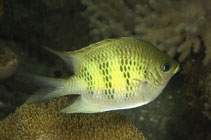| Family: |
Pomacentridae (Damselfishes), subfamily: Pomacentrinae |
| Max. size: |
11 cm TL (male/unsexed) |
| Environment: |
reef-associated; marine; depth range 1 - 40 m, non-migratory |
| Distribution: |
Western Pacific: Rowley Shoals (eastern Indian Ocean) and Malaysia to Samoa and Tonga (Ref. 53797), north to the Ryukyu Islands, south to the Great Barrier Reef. |
| Diagnosis: |
Dorsal spines (total): 13-13; Dorsal soft rays (total): 12-13; Anal spines: 2-2; Anal soft rays: 13-15. Description: Several geographical variations. Indonesian populations green with dusky bars when adult. Irian Jaya fish maybe more silvery with greenish bars that ranges from Japan to eastern Australia (Ref. 48636). Body depth 1.6-1.7 in SL. Suborbital scaled (Ref. 90102). |
| Biology: |
Adults inhabit lagoons, coastal embayments, reef passages and outer reefs. Juveniles often found among Sarcophyton and Sinularia soft corals. Feeding aggregations are frequently observed over growths of the staghorn coral Acropora. Feed on zooplankton and filamentous algae (Ref.1602). The stomach contents of a specimen included larval crabs and shrimps, fish eggs, and algae. Oviparous, distinct pairing during breeding (Ref. 205). Dead coral branches serve as nests (Ref. 90102). Eggs are demersal and adhere to the substrate (Ref. 205). Males guard and aerate the eggs (Ref. 205). |
| IUCN Red List Status: |
Least Concern (LC); Date assessed: 16 November 2010 Ref. (130435)
|
| Threat to humans: |
harmless |
Source and more info: www.fishbase.org. For personal, classroom, and other internal use only. Not for publication.

